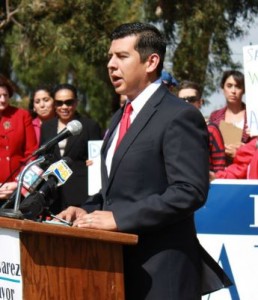
The path to an Alvarez victory is perhaps the most easily visible, as former Mayor Filner walked it just last year. It’s called solidify your base.
Despite his own negatives, two moderate candidates and arguably lackluster early campaigning, the party machine turned out 30 percent of the primary vote for Filner. If Alvarez can reach that number, or improve on it slightly, he likely makes it to the general. Can he do it? Yes.
The 10 News/U-T San Diego poll showing him at 17 percent isn’t as problematic as it might sound. As a first term councilmember who didn’t enter until higher profile Democrats had deferred, Alvarez lags in name recognition. That can be fixed by debate coverage and biography ads that are already on television. Alvarez’s numbers will also likely improve as voters engage in the race. Filner, who had little problem with name recognition, saw his numbers rise from 20 percent in an April poll to 30 percent on Election Day.
His narrative should make progressives swoon: a squeaky clean San Diego native who would like to remove the obstacles he had to overcome. If 30 percent of San Diegans chose Filner for his policies, how many might support a progressive Democrat without the baggage and bluster? How many new voters might come out to elect the first Latino mayor in more than a century?
Still, Filner was facing a middle divided by District Attorney Dumanis and former Assemblymember Nathan Fletcher. Can Alvarez get past moderates united behind Fletcher? Again, yes.
One race with certain parallels was the CA-52 in 2010. Democrats flocked to now Rep. Scott Peters in the general, but the primary was a different story. Former Rep. Brian Bilbray locked up the conservative vote at 41 percent and trained most of his fire on Peters, similar to what Councilmember Faulconer may do with Fletcher. The more moderate and business friendly Peters’ 22.6 percent barely bested former Assemblywoman Lori Saldana’s 22.1 percent. Alvarez has endorsements from the Democratic Party, which Saldana didn’t, and the Labor Council, which Peters did. In reality, Alvarez doesn’t need to hit a polling number. He needs to cross the threshold of electability, at which point progressive Democrats have less reason to support other candidates, including but not limited to Fletcher. Can he get there? Absolutely, though it’s no slam dunk. If he does, the Democratic and Labor turn-out machines should be able to take it from there.











